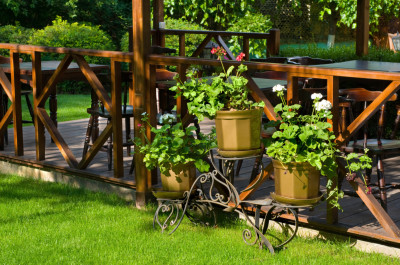Why and How To Use Patio Edging

Patio edging is necessary to prevent the encroachment of nearby grass, weeds or vegetation from making its way onto your patio; therefore, keeping your patio looking clean and well-groomed. Of course you'll need to know how to choose and install patio edging, as there are many different types available. Here we'll take a closer look at some of the different types and how you can go about installing it around your patio.
Why Patio Edging Is Important
The main purpose of patio edging is to simply keep weeds and vegetation from growing onto your patio. Although most people assume weed overgrowth is strictly an aesthetic issue, it can actually cause damage to the structural integrity of your patio. For instance, if you have a concrete-based patio, surface, the growth of weeds may cause hairline cracks and fractures, which could lead to more severe problems down the road. To prevent this, edging should be installed around the perimeter of your patio.
The stylish look provided by patio edging is another reason why homeowners use them. No matter what shape or design your patio is, chances are edging will compliment its natural look.
How To Choose Patio Edging
If you've never shopped for patio edging before, you might be surprised at just how many different types there are available. You can find them made of concrete, wood, brick, ceramic and even plastic polymers. With so many choices, how do you know which one is right for your patio?
The two primary features you need to look for in patio edging are functionality and appeal. No matter what type you decide on going with, it needs to be durable enough to withstand moisture and consequently rot. Don't make the mistake of digging up a trench around the perimeter of your patio and installing unfinished 2x4s in it, as they will rot away in a matter of weeks. If you intend on using wood, it must be treated and finished with a protective coating to repel moisture.
Installing Patio Edging
The method for installing patio edging varies depending on the type used. Typically, the first thing you'll need to do is dig up the soil to a specified depth around the perimeter of your home. Once the soil is dug up, the next step is to bury the edging material inside. Now, you can either leave the edging buried completely underneath the soil, or you can allow it to protrude out of the soil. If you allow the edging to stick out of the soil, you'll need more materials to install it.
Recent Posts
-
Fire Safety in the Workplace: What You Need to Know
What steps are you taking to prevent fires in your workplace? According to the U.S. Occupational Saf …Aug 23rd 2023 -
Is It Safe to Go Jogging With a Cold Infection?
If you're suffering from a cold infection, you might be wondering whether it's safe to go jogging. T …Aug 22nd 2023 -
5 Safety Tips to Follow When Using a Powder-Actuated Tool
Powder-actuated tools are commonly used to join materials to steel and concrete. Also known as Hilti …Aug 20th 2023




